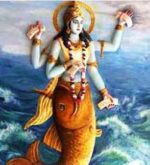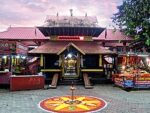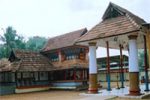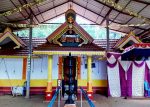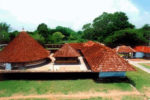Temple Name:
Alternate Spellings:
Sree Malsyavathara Mahavishnu Temple
Listing Category
Significance:
Devotees visit this temple to seek fulfillment of the following:-
Fame | Freedom from diseases | Wealth | Courage | Relief from adverse effects from bad planetary aspects | Relief from bondage
Fame | Freedom from diseases | Wealth | Courage | Relief from adverse effects from bad planetary aspects | Relief from bondage
Location:
Meenangadi
Address:
Sree Malsyavathara Mahavishnu Temple, Meenangadi, Wayanad District, Kerala
District:
Wayanad
Google Tag:
9.971820, 76.299646
Email id:
NA
Temple Timings:
6AM to 9PM
Temple Type:
Dewaswom
Presiding deity:
Sri Malsyamoorthy is the principal deity. However, the idol is that of Lord Maha Vishnu.
Sub Deities:
Lord Ganapathy, Lord Ayyappa, Goddess Durga are the sub deities.
Festivals:
Annual festival in the month of Kumbham is the main festival. It is observed on Uthrittathi asterisk.
History:
The sanctuary is accepted to have built in eleventh Century. The sanctuary was devoted to the Malsya Avathara of Lord Maha Vishnu (first incarnation among 10 incarnations). At first, the sanctuary was kept up by the tribes of the area. As they were not able to deal with the sanctuary, a Kshethra Samithy (Temple Committee) was shaped and it assumed control over the administration in 1983. Legend says that the place got its name because of the nearness of this sanctuary. The word Meen in Malayalam implies Malsya or fish. Angadi implies an open commercial center. The commercial center where large number of people used to visit. Malsyamoorthy sanctuary was named as Meenangadi.
Updated on:
05/07/2019 by Komal
Temple Name:
Listing Category
Significance:
Malayalapuzha Devi is believed to grant boons for extending prosperity to all the devotees. The goddess is worshiped for protecting the devotee from enemies, getting the unmarried girls married, obtaining job for the unemployed, and helping businesses flourish. This popular belief and faith makes the temple visited by devotees from far locations. The devi is also known as Goddess Idathattil Bhagwathi
Location:
Malayalapuzha
Address:
Malayalapuzha Devi Temple, Malayazhapuzha Devaswam, Kumbazha Malayalapuzha Rd, Malayalapuzha, Pathanamthitta, Kerala
District:
Pathanamthitta
Google Tag:
9.2883° N, 76.8229° E
Phone No:
+91 4682300260
Temple Timings:
5 AM to 1 PM | 5 PM to 8 PM
Temple Type:
Dewaswom
Presiding deity:
Bhagvathy Bhadrakali
Sub Deities:
Brahma Rakshas, Nagaraja and a swayambu Shiva Linga.
Offerings:
Offerings include Thoniyari Payasam (sweet rice), Ney Vilakku (lighting of ghee lamps), Nirapara (offering of rice, paddy and sugar to the brim of the measuring vessel called para). Ablutions are done with white ash, sandal, oil, milk, ghee and tender coconut water too.
Festivals:
Vinayaka Chathurthi, Navarathri, Sivarathri and other major festivals are celebrated in a grand manner. Tuesdays and Fridays are important days in all Devi temples. The heavy rush on those days can make you wait for darshan (viewing). The annual festival of Malayalapuzha Devi Temple starts on the day of the star Thiruvathira in Kumbham (February–March). Aarattu (dipping the deity in the temple tank or river) is performed on the eleventh day.
History:
Once upon a time, two people belonging to the Namboothiri caste of northern Travancore were meditating at Mookambika temple. They had with them an idol of Bhadrakali. After their meditation for a prolonged period, they received an oracle from Bhadrakali that the idol will have her perpetual presence. The Namboothiris continued their pilgrimage with the idol in their possession. As they became too old to continue their pilgrimage, Bhadrakali appeared before them and advised that Malayalappuzha was the ideal place to erect the idol. Following her advice, the Namboothiris reached Malayappuzha and erected the idol.
Updated on:
05/07/2019 by Komal
Temple Name:
Alternate Spellings:
Manarkadu Bhagavathy
Listing Category
Location:
Manarcad
Address:
Manarcad Bhagavathy Amma, Manarcadu – Kidangoor Rd, Manarcadu, Kerala
District:
Kottayam
Google Tag:
NA
Phone No:
0481 237 0418
Email id:
info@manarkattamma.org
Temple Timings:
NA
Temple Type:
Other
Presiding deity:
Goddess Bhadrakali
Updated on:
05/07/2019 by Komal
Temple Name:
Alternate Spellings:
Mangala Devi Temple
Listing Category
Significance:
The temple stands amidst the thick Periyar Tiger Reserve, and is one of the unique temples in South India. People visit the temple not only to seek blessings from the deity, but also to experience the wilderness of the surroundings.
Location:
Kumily, Idukki
Address:
Kumily Peermede Taluk, Idukki
District:
Idukki
Google Tag:
9°34′55″N 77°13′59″E
Temple Timings:
April – May
Temple Type:
Other
If Other is Chosen, pls specify:
Protected & Preserved by Kerala Ancient Monuments and Archaeological Sites and Remains Act of 1968
Presiding deity:
Mangaladevi Kannagi
Sub Deities:
NA
Festivals:
Chithra Pournami
History:
The temple was built by Cheran Chenguttuvan, the king of ancient Tamilakam, around 2000 years back at Vannathiparai and named it 'Kannagi Kottam' or Mangaladevi Kannagi Temple. The temple is situated at an altitude of about 1,337 m above sea level and is famous for its Pandyan architecture. The boundary walls and the steps leading to the temple are made up of huge stones.
Updated on:
05/07/2019 by Komal
Temple Name:
Alternate Spellings:
Mayathi Devi Temple
Listing Category
Significance:
People suffering from many sorrows or any mental difficulties in their life, if once he /she visits amma and pray from the bottom of heart to recover the sorrows , sure amma can transform them with peaceful mind and health.
Location:
Balanthode
Address:
Mayathi Sree Bhagavathi Temple Devaswom, balanthode. panathady .p.o, kasaragode (district)
671532
671532
District:
Kasargode
Google Tag:
12.4616784,75.3146052
Phone No:
0467- 2229266 2228393
Email id:
info@mayathisreebhagavathitemple.in
Temple Timings:
6:30am – 11:30am | 6:00pm – 7:30pm
Temple Type:
Dewaswom
Presiding deity:
Devi Lakshmi
Sub Deities:
NA
Updated on:
05/07/2019 by Komal
Temple Name:
Alternate Spellings:
Muzhakunnu Mridanga Saileswari
Listing Category
Significance:
Mridanga Saileswari Devi is renowned to shower her blessings to all those who pray earnestly before her, lighting the ghee lamp. The diety, Goddess Durga is omnipotent, easy to please, demolisher of evils and foes, and is celebrated as one who grants all the wishes of devotees instantly!
The extreme power of the goddess and the deity’s ability to bless the devotees with even the ‘IMPOSSIBILITIES’.
The extreme power of the goddess and the deity’s ability to bless the devotees with even the ‘IMPOSSIBILITIES’.
Location:
Muzhakunnu
Address:
Muzhakkunnu Mridanga Saileswari Devi Temple, P.O. Muzhakkunnu, Peravoor (via) Kannur (Dt), Kerala
District:
Kannur
Google Tag:
11° 37′ 27.5952” N, 79° 30′ 8.4096” E
Phone No:
9400208034 9400286777 04902406408
Email id:
NA
Temple Timings:
05:00 AM to 01:00 PM | 05:00 PM to 08:00 PM
Temple Type:
Other
If Other is Chosen, pls specify:
Central Government
Presiding deity:
Durga as Saraswati (Mridanga Shaileshwari) and Chamunda (Porkali)
Sub Deities:
NA
History:
Muzhakkunnu Sree Mridanga Saileswari Temple is a traditional temple situated at the village of Muzhakkunnu in Kannur district. It is the family diety of Kerala Lion Veera Pazhassi Raja. The temple is believed to be constructed by Lord Parasurama along with the 108 Durga temples. The famous prayer lines of Kathakali is known to have been written in this temple as it is the praise of Porkkali Devi.
The existing myth speaks about a drum like musical instrument that fell from heaven called Mridungam. This gave rise to the names Mridungasailam and mizhavukkunnu, to the place. There is a lower trough in the temple premises which is believed to be the ground where the mizhavu fell from the skies.
The existing myth speaks about a drum like musical instrument that fell from heaven called Mridungam. This gave rise to the names Mridungasailam and mizhavukkunnu, to the place. There is a lower trough in the temple premises which is believed to be the ground where the mizhavu fell from the skies.
Updated on:
05/07/2019 by Komal
Temple Name:
Alternate Spellings:
Kerala Mookambika Shetram | Mulavallikav Saraswathi Temple
Listing Category
Significance:
Mulavallikav devi is believed to be “Sarvabeeshtapradhayini” (one who grants all wishes). Pilgrims who pray with sincerety and with utmost devotion will be blessed with health, wealth and all.
Location:
Koratty
Address:
Kerala Mookambika Sree Mulavallikav Devi Temple, Near NUP School, Behind NSS Karayogam Hall,West Koratty, P.O.Mambra,Trichur, Kerala
District:
Thrissur
Google Tag:
10°14’51″N 76°21’4″E
Phone No:
9947420782 9895968168 9496531750
Email id:
NA
Temple Timings:
Sunday 6am – 9am
Temple Type:
Other
If Other is Chosen, pls specify:
Kshethra Samrakshana Samithi
Presiding deity:
Bhagavathy Saraswathy Devi
Sub Deities:
NA
History:
Kerala Mookambika Sree Mulavallikav Devi Temple is considered as one of the most important devi temples among the 108 durga temples (77th) believed to have been consecrated by the legendary warrior Parasurama who is also credited with creating the state of kerala.
The Mulavallikav Devi (soyambhu) Temple known as Mulavallikav Saraswathi Temple, Koratty Devi Temple and also known as "Kerala Mookambika Shetram" (Kerala mookambika Temple) because of whatever mulavallikav devi pooja vidhi all are same in Kollur Mookambika Devi Temple.
According to the legends, lord parasurama created the land between gokarna and kanyakumari. Lord parasurama the sixth incarnation of lord vishnu was the son of sage jamadagni and renuka. As a mark of repentance for shatriya nigraha sin, parasurama meditated at gokarna and invoked lord varuna (the lord of the oceans). Parasurama asked him for a boon to absolve himself of the sins he had committed, he wanted to donate some land to the brahmins. There was no land available because he already donated the whole land he obtained by the 21 round shatriya nigraha to sage kashyapa. Lord varuna told parasurama that he would give him as much land as he wished. He told him to fling his parasu (axe) from where he stood at gokarna. The land from gokarna till the point where the axe landed would be given to him was the boon that lord varuna promised him. The throw of the `axe' from gokarna to kanyakumari created kerala. Parasurama donated this land to the brahmins and settled brahmins there in 64 gramams or villages. 32 out of the 64 gramams are in the Tulu speaking region (in between gokarnam and perumpuzha) and the remaining 32 grammams are in the malayalam speaking region(in between perumpuzha and kanyakumari) in kerala. After the creation of these gramams, parasurama had consecrated 108 shiva temples and 108 durga temples for the well-being and prosperity of the people in kerala . The names of these temples were given in the famous 108 Durgalaya Nama Stothra and 108 shivalaya nama stothra.
The Mulavallikav Devi (soyambhu) Temple known as Mulavallikav Saraswathi Temple, Koratty Devi Temple and also known as "Kerala Mookambika Shetram" (Kerala mookambika Temple) because of whatever mulavallikav devi pooja vidhi all are same in Kollur Mookambika Devi Temple.
According to the legends, lord parasurama created the land between gokarna and kanyakumari. Lord parasurama the sixth incarnation of lord vishnu was the son of sage jamadagni and renuka. As a mark of repentance for shatriya nigraha sin, parasurama meditated at gokarna and invoked lord varuna (the lord of the oceans). Parasurama asked him for a boon to absolve himself of the sins he had committed, he wanted to donate some land to the brahmins. There was no land available because he already donated the whole land he obtained by the 21 round shatriya nigraha to sage kashyapa. Lord varuna told parasurama that he would give him as much land as he wished. He told him to fling his parasu (axe) from where he stood at gokarna. The land from gokarna till the point where the axe landed would be given to him was the boon that lord varuna promised him. The throw of the `axe' from gokarna to kanyakumari created kerala. Parasurama donated this land to the brahmins and settled brahmins there in 64 gramams or villages. 32 out of the 64 gramams are in the Tulu speaking region (in between gokarnam and perumpuzha) and the remaining 32 grammams are in the malayalam speaking region(in between perumpuzha and kanyakumari) in kerala. After the creation of these gramams, parasurama had consecrated 108 shiva temples and 108 durga temples for the well-being and prosperity of the people in kerala . The names of these temples were given in the famous 108 Durgalaya Nama Stothra and 108 shivalaya nama stothra.
Updated on:
05/07/2019 by Komal
Temple Name:
Alternate Spellings:
Nadackal bhagavathi Temple
Listing Category
Location:
Nadakkal, Erattupetta
Address:
Nadackal bhagavathi Temple, Nadackal, Erattupetta, Kerala,Kottayam
District:
Kottayam
Google Tag:
NA
Email id:
NA
Temple Timings:
NA
Temple Type:
Dewaswom
Presiding deity:
Bhagavathy Bhadrakali
Sub Deities:
NA
Offerings:
The main offwerings are Enna Vilakku, Nada Guruthi,Manjal Abhishekam.
Festivals:
The Annual festivals are Meena BharaniAnd athamudayam on April 23rd every Year.
History:
This temple is more than 1000 years old and belongs to the Poonjar Koickal Devaswom group of temples. The Trustee of the temple is the Valiya Raja of Poonjar (Poonjar Chief.)
Updated on:
05/07/2019 by Komal
Temple Name:
Alternate Spellings:
Neithalakkavu Temple
Listing Category
Location:
Kuttur
Address:
Sri Naithalakkavu temple
(Cochin Devaswom Board)
Kuttur -Thrissur
(Cochin Devaswom Board)
Kuttur -Thrissur
District:
Thrissur
Phone No:
+91 487 2382220 +91 9446037681
Email id:
naithalakkavutemple@gmail.com
Temple Timings:
5am – 10am; 5:30pm – 7:30pm
Temple Type:
Dewaswom
Presiding deity:
Lord Siva and Naithalakkavu Amma
Sub Deities:
Sri Durga, Shastra, Ganapathi, Anthimahakalan, Rashasu & Dampathu Rashasu
Updated on:
05/07/2019 by Komal
Temple Name:
Alternate Spellings:
Nelluvai Sree Dhanwanthari Temple
Listing Category
Significance:
It is believed that all type of diseases can be cured by worshipping Lord Dhanwanthari. Large number of devotees visit this temple for this purpose.
Location:
Nelluwaya
Address:
Nelluvai Pattambi Road, Nelluwaya, Kerala
680584
680584
District:
Thrissur
Google Tag:
NA
Phone No:
094476 17612, 04885-264269
Email id:
admin@nelluvaidhanwantharitemple.org
Temple Timings:
5am - 10:30am | 5pm - 8pm
Temple Type:
Dewaswom
Presiding deity:
Lord Dhanwanthari - another manifestation of Lord Maha Vishnu
Sub Deities:
NA
Offerings:
Udayasthamana Pooja
Dhanwanthari Homam
Dhanwanthari Pooja
Dhanwanthari Archana
Mukkudi Nivedyam
Attayum Kuzhambum
Niramaala Chuttuvilakku
Thiruvona Oottu
Bhajanam
Dhanwanthari Homam
Dhanwanthari Pooja
Dhanwanthari Archana
Mukkudi Nivedyam
Attayum Kuzhambum
Niramaala Chuttuvilakku
Thiruvona Oottu
Bhajanam
Festivals:
VAIKUNDA EKADHASI / Swargavaathil Ekadashi
The Swargavaathil Ekadashi in Veluththa Paksham in Malayalam month Dhanu is very important. The Shuddhi Karmas starts from Ashtami. There will be Navakam, Panchagavyam and Sreebhoothabali on this special occasion. There will be Vilakkezhunnallippu and Udayaasthamana Pooja as well. These Vazhipaadu are being offered by different devotees. There will be Pakalppooram on the Ekadashi Day only. The Ezhunnallippu from the Sreekovil will have only the Kolam; one maala will be adorned on it and there will be no Thidambu. One thing is to be remembered that the many elephants that are taking part in the Ezhunnallippu are arranged without any cost (Ekkam) to the temple; it will be totally free of cost. If the elephants are affected by abdominal complaints or any other related disorders, the owners used to pray before the Dhanvanthari Moorthy and offer to provide the elephant for the Ezhunnallippu free of cost. After completing the Melam in Pakalppooram in the western entrance, Nadakkal Para is usually being arranged that is offered by many devotees as a special Vazhipaadu. The performers of the musical instruments (thaalavadyam) are attending here just to offer themselves to the Lord Dhanvanthari and not for any reward. The Ezhunnallippu will also be performed during night. The main programs including Panchavaadyam, Thayambaka, Keli, and Melam will be performed accordingly, as scheduled.
NIRAMAALA
The offering made by arranging and decorating flower garlands and lighted lamps inside the Sanctum Sanctorum as well as all around the templeis called Niramaala. The Ezhunnallippu using the elephants, Panchavadyam, Thayambaka and Melam are the main attractions of Niramaala vilakku. In addition, Paattukachcheri, Dance, Harikadha, Kadhakali, etc. are also taking part associated with the Niramaala vilakku. It is believed that if a devotee comes to see Lord Dhanvanthari on the special day of Swargavaathil Ekadasi, he will get one year’s benefit out of it. Niramaala, Prathishthaadinam, Ashtamirohini, Kucheladinam, Guruvayoor Ekadashi, Sthrothra Panchashika Day, etc. are the important occasions in this temple.
The Swargavaathil Ekadashi in Veluththa Paksham in Malayalam month Dhanu is very important. The Shuddhi Karmas starts from Ashtami. There will be Navakam, Panchagavyam and Sreebhoothabali on this special occasion. There will be Vilakkezhunnallippu and Udayaasthamana Pooja as well. These Vazhipaadu are being offered by different devotees. There will be Pakalppooram on the Ekadashi Day only. The Ezhunnallippu from the Sreekovil will have only the Kolam; one maala will be adorned on it and there will be no Thidambu. One thing is to be remembered that the many elephants that are taking part in the Ezhunnallippu are arranged without any cost (Ekkam) to the temple; it will be totally free of cost. If the elephants are affected by abdominal complaints or any other related disorders, the owners used to pray before the Dhanvanthari Moorthy and offer to provide the elephant for the Ezhunnallippu free of cost. After completing the Melam in Pakalppooram in the western entrance, Nadakkal Para is usually being arranged that is offered by many devotees as a special Vazhipaadu. The performers of the musical instruments (thaalavadyam) are attending here just to offer themselves to the Lord Dhanvanthari and not for any reward. The Ezhunnallippu will also be performed during night. The main programs including Panchavaadyam, Thayambaka, Keli, and Melam will be performed accordingly, as scheduled.
NIRAMAALA
The offering made by arranging and decorating flower garlands and lighted lamps inside the Sanctum Sanctorum as well as all around the templeis called Niramaala. The Ezhunnallippu using the elephants, Panchavadyam, Thayambaka and Melam are the main attractions of Niramaala vilakku. In addition, Paattukachcheri, Dance, Harikadha, Kadhakali, etc. are also taking part associated with the Niramaala vilakku. It is believed that if a devotee comes to see Lord Dhanvanthari on the special day of Swargavaathil Ekadasi, he will get one year’s benefit out of it. Niramaala, Prathishthaadinam, Ashtamirohini, Kucheladinam, Guruvayoor Ekadashi, Sthrothra Panchashika Day, etc. are the important occasions in this temple.
History:
The idol that is worshipped in Nelluvai Temple is of God “Dhanvanthari”. God Dhanvanthari who came out during Paalaazhi Madhanam stays here in this temple with a view to protect the world from all dangers and ill-doings. There is a story behind the Dhanvanthari Idol and Cheruthevar:
Sri. K.M. Shankara Iyear, in his book Nelluvai Shathakam has narrated this story in detail. Long back, as the existing idol in Nelluvai Temple got damaged, it was decided to make a new idol, and accordingly, the idol work was carried out from a suitable stone on a small hill at a place called Muringaththeri. After finishing the work of this idol, a procession was arranged involving all the devotees in the village with all the traditional poojas and they were proceeding to the temple where the idol was supposed to be fixed. During their passage to the temple, the Ashwini Devatasat once came in front of the procession and they handed over an idol which is believed to be offered pooja by Vasudevar, and informed the people that this idol should be fixed in the temple, and the Ashwini Devatas got disappeared from the site. Accordingly, the Sadhus fixed this idol in the Sanctum Sanctorum of Nelluvai Temple. The Vaishnava idol which was carved out in the Muringaththeri Hill was fixed in a newly arranged small temple in a nearby village called Cheruthevar Parambu. Later on, a small temple was constructed in the Nelluvai Temple itself just beside the main Sanctum Sanctorum and this Vaishnava Idol was re-fixed in this new place. The idol that is fixed in the main Sanctum Sanctorum has a very long history.
The Dhanvanthari Moorthi that is worshipped in the Nelluvai Temple is supposed to be the God of Physicians (Ayurveda). It is believed that they will be provided with good and favorable treatment results to their patients if they devote completely to the Dhanvanthari Moorthi with full Bhakthi and commitment. The famous and notable physicians who performed Bhajans to the Dhanvanthari Moorthi include Kuttancheri Moos, Vaidyarathnam P.S. Warrier, Aryavaidyan P.V. Rama Warrier, etc., and they excelled in their profession too with the help of the Deity. Even in this modern era, the Ayurvedic Physicians, before stepping into their profession, have been performing Bhajans in the temple and reading Ashtamgahridaya, which isthe basic and prime book of Ayurveda. It is highly believed that this offering will give them more knowledge and help is getting more success in their profession. The well-knowledgeable and all famous poet Melpathur Bhattathiri offered Bhajans to Lord Guruvayoorappa and wrote the famous poem Narayaneeyam and got relieved from rheumatoid arthritis. Similarly, it is said that the famous Astrologist and Poet Vidvan Machatt Ilayath who performed Bhajans before the Dhanvanthari Moorthi in Nelluvai Temple and wrote the poetry Sthrothra Panchashika got complete relief from his skin disease. The poem Sthrothra Panchashika was offered to the God on the 1st of Malayalam month Kumbham. This day is being celebrated as the Sthrothra Panchashika Day every year. The Dhanvanthari Asthothara Namajapa and Sthrothra Panchashika parayana is believed to be worthwhile to the children and elders alike for their better prosperity and to increas their wisdom and for removing all their physical and mental illnesses.
The Temple Renovation Committee (Khethroddharana Samithi) was formed on January 10, 1971. Under this Committee’s supervision and control, the required fund had been raised and got the damages of the temple repaired. When the Temple Authorities found it difficult to carry out the normal activities of the temple, they approached the Kochi Devaswom Board Authorities with a request to take over the temple. Consequently, The Kochi Devaswom Board took over the temple administration and appointed a Temple Trust, to carry out the routine activities of the Temple. Thereafter, the Kochi Devaswom Board directly took over the temple administration since 1st May 1979.
In the past, from Thulam 1st to Thulam 12 every year, a Thevar Seva was carried out in the temple. Kuttanjeri Moos was supposed to be its originator. During this period, Navagam and panchagavyamwere offered as Nivedyam and a grant feast was served with the involvement of the whole people from the society.
The Niramala Vazhipadu was first started in Kollavarsham 1098 in Nelluvai Temple. Sri. Kuttancheri Moos was the then President of the Niramala Committee and he worked very hard to carry out this special pooja. During those days, Malavilakku, Nadasvaram, Ezhunnellippu, Thayampaka and Panchavadyam were the important things that took place in the Niramala Vazhipadu. The Niramala got resumed in the year 1962 under the leadership of a Committee headed by Messrs. Nelluvai K.N. Nambeesan, N.S. Ganapathi Iyer with the full cooperation of the general public.
Sri. K.M. Shankara Iyear, in his book Nelluvai Shathakam has narrated this story in detail. Long back, as the existing idol in Nelluvai Temple got damaged, it was decided to make a new idol, and accordingly, the idol work was carried out from a suitable stone on a small hill at a place called Muringaththeri. After finishing the work of this idol, a procession was arranged involving all the devotees in the village with all the traditional poojas and they were proceeding to the temple where the idol was supposed to be fixed. During their passage to the temple, the Ashwini Devatasat once came in front of the procession and they handed over an idol which is believed to be offered pooja by Vasudevar, and informed the people that this idol should be fixed in the temple, and the Ashwini Devatas got disappeared from the site. Accordingly, the Sadhus fixed this idol in the Sanctum Sanctorum of Nelluvai Temple. The Vaishnava idol which was carved out in the Muringaththeri Hill was fixed in a newly arranged small temple in a nearby village called Cheruthevar Parambu. Later on, a small temple was constructed in the Nelluvai Temple itself just beside the main Sanctum Sanctorum and this Vaishnava Idol was re-fixed in this new place. The idol that is fixed in the main Sanctum Sanctorum has a very long history.
The Dhanvanthari Moorthi that is worshipped in the Nelluvai Temple is supposed to be the God of Physicians (Ayurveda). It is believed that they will be provided with good and favorable treatment results to their patients if they devote completely to the Dhanvanthari Moorthi with full Bhakthi and commitment. The famous and notable physicians who performed Bhajans to the Dhanvanthari Moorthi include Kuttancheri Moos, Vaidyarathnam P.S. Warrier, Aryavaidyan P.V. Rama Warrier, etc., and they excelled in their profession too with the help of the Deity. Even in this modern era, the Ayurvedic Physicians, before stepping into their profession, have been performing Bhajans in the temple and reading Ashtamgahridaya, which isthe basic and prime book of Ayurveda. It is highly believed that this offering will give them more knowledge and help is getting more success in their profession. The well-knowledgeable and all famous poet Melpathur Bhattathiri offered Bhajans to Lord Guruvayoorappa and wrote the famous poem Narayaneeyam and got relieved from rheumatoid arthritis. Similarly, it is said that the famous Astrologist and Poet Vidvan Machatt Ilayath who performed Bhajans before the Dhanvanthari Moorthi in Nelluvai Temple and wrote the poetry Sthrothra Panchashika got complete relief from his skin disease. The poem Sthrothra Panchashika was offered to the God on the 1st of Malayalam month Kumbham. This day is being celebrated as the Sthrothra Panchashika Day every year. The Dhanvanthari Asthothara Namajapa and Sthrothra Panchashika parayana is believed to be worthwhile to the children and elders alike for their better prosperity and to increas their wisdom and for removing all their physical and mental illnesses.
The Temple Renovation Committee (Khethroddharana Samithi) was formed on January 10, 1971. Under this Committee’s supervision and control, the required fund had been raised and got the damages of the temple repaired. When the Temple Authorities found it difficult to carry out the normal activities of the temple, they approached the Kochi Devaswom Board Authorities with a request to take over the temple. Consequently, The Kochi Devaswom Board took over the temple administration and appointed a Temple Trust, to carry out the routine activities of the Temple. Thereafter, the Kochi Devaswom Board directly took over the temple administration since 1st May 1979.
In the past, from Thulam 1st to Thulam 12 every year, a Thevar Seva was carried out in the temple. Kuttanjeri Moos was supposed to be its originator. During this period, Navagam and panchagavyamwere offered as Nivedyam and a grant feast was served with the involvement of the whole people from the society.
The Niramala Vazhipadu was first started in Kollavarsham 1098 in Nelluvai Temple. Sri. Kuttancheri Moos was the then President of the Niramala Committee and he worked very hard to carry out this special pooja. During those days, Malavilakku, Nadasvaram, Ezhunnellippu, Thayampaka and Panchavadyam were the important things that took place in the Niramala Vazhipadu. The Niramala got resumed in the year 1962 under the leadership of a Committee headed by Messrs. Nelluvai K.N. Nambeesan, N.S. Ganapathi Iyer with the full cooperation of the general public.
Updated on:
05/07/2019 by Komal
